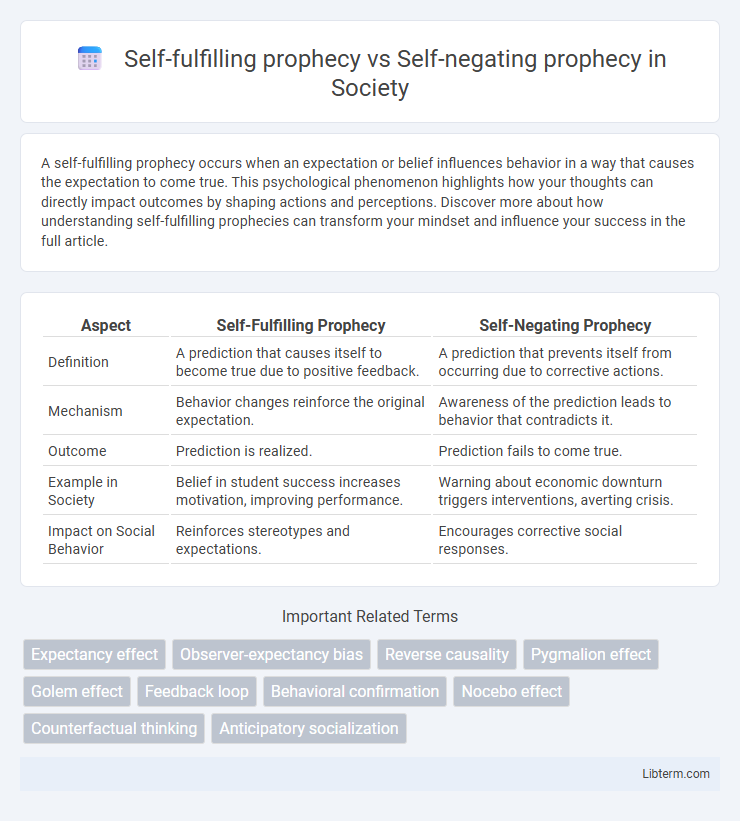A self-fulfilling prophecy occurs when an expectation or belief influences behavior in a way that causes the expectation to come true. This psychological phenomenon highlights how your thoughts can directly impact outcomes by shaping actions and perceptions. Discover more about how understanding self-fulfilling prophecies can transform your mindset and influence your success in the full article.
Table of Comparison
| Aspect | Self-Fulfilling Prophecy | Self-Negating Prophecy |
|---|---|---|
| Definition | A prediction that causes itself to become true due to positive feedback. | A prediction that prevents itself from occurring due to corrective actions. |
| Mechanism | Behavior changes reinforce the original expectation. | Awareness of the prediction leads to behavior that contradicts it. |
| Outcome | Prediction is realized. | Prediction fails to come true. |
| Example in Society | Belief in student success increases motivation, improving performance. | Warning about economic downturn triggers interventions, averting crisis. |
| Impact on Social Behavior | Reinforces stereotypes and expectations. | Encourages corrective social responses. |
Understanding Self-Fulfillment and Self-Negation
Self-fulfilling prophecy occurs when an individual's belief or expectation influences their behavior, causing the predicted outcome to materialize, reinforcing the original expectation. In contrast, self-negating prophecy happens when a prediction or belief leads to actions that prevent the expected outcome from occurring, effectively negating the initial expectation. Understanding self-fulfillment involves recognizing how positive or negative expectations can shape reality, while self-negation highlights the role of conscious intervention in altering anticipated results.
Defining Self-Fulfilling Prophecies
A self-fulfilling prophecy occurs when an individual's belief or expectation influences their behavior in a way that causes the belief to become true. This concept is central to social psychology, illustrating how positive or negative predictions can shape outcomes through actions and reactions. Understanding self-fulfilling prophecies is crucial for recognizing how perceptions impact reality and behavior.
The Power of Belief: How Expectations Shape Outcomes
Expectations play a crucial role in shaping outcomes through the mechanisms of self-fulfilling and self-negating prophecies, where belief directly influences behavior and results. In a self-fulfilling prophecy, positive expectations lead to actions that confirm those beliefs, enhancing performance and success, while in a self-negating prophecy, negative expectations trigger behaviors that undermine potential, causing failure or underachievement. Cognitive and emotional responses to these beliefs activate psychological and social processes, demonstrating the power of mindset in determining real-world outcomes.
Self-Negating Prophecy: Definition and Mechanisms
Self-negating prophecy occurs when an initial prediction or belief prompts actions that prevent the predicted event from happening, effectively invalidating the original forecast. Mechanisms driving self-negating prophecy include increased vigilance, behavioral adjustments, and proactive interventions aimed at averting the expected outcome. This phenomenon contrasts with self-fulfilling prophecy, where expectations directly contribute to the occurrence of the predicted event.
Psychological Foundations Behind Prophetic Effects
Self-fulfilling prophecies arise from psychological mechanisms like expectation-driven behavior and confirmation bias, where individuals act in ways that make predictions come true. In contrast, self-negating prophecies occur when expectations lead to behaviors that prevent the predicted outcome, often driven by psychological processes such as reactance or corrective cognition. Both phenomena highlight the powerful role of belief systems, cognitive biases, and social feedback loops in shaping individual and group behavior within psychological frameworks.
Real-Life Examples: Self-Fulfilling vs Self-Negating
A self-fulfilling prophecy occurs when an individual's belief or expectation influences their behavior in a way that causes the belief to come true, such as a student excelling academically because they believe they will succeed. In contrast, a self-negating prophecy happens when an expectation leads to behaviors that prevent the anticipated outcome, for example, an employee doubting their promotion chances who then avoids taking initiative, ultimately missing opportunities. Real-life cases in education, workplace performance, and social interactions illustrate how these prophecies shape outcomes through psychological and behavioral feedback loops.
Impacts on Behavior and Personal Development
Self-fulfilling prophecies shape behavior by reinforcing positive expectations, leading individuals to act in ways that fulfill those beliefs, thereby boosting confidence and personal growth. In contrast, self-negating prophecies trigger behaviors that undermine initial expectations, causing individuals to act contrary to positive outcomes and hindering personal development. Understanding these dynamics is crucial for fostering adaptive mindsets and improving behavioral interventions.
Societal and Cultural Influences on Prophecy Cycles
Societal and cultural influences shape self-fulfilling prophecies by reinforcing expectations that drive behavior aligned with predicted outcomes, often perpetuating social norms and power structures. In contrast, self-negating prophecies emerge when collective awareness and cultural resistance disrupt anticipated cycles, leading to outcomes that invalidate the original prediction. These dynamics are evident in social phenomena such as economic forecasts, political movements, and public health responses, where cultural context and group beliefs critically influence the manifestation of prophecy cycles.
Breaking the Cycle: Strategies to Counter Prophetic Traps
Breaking the cycle of self-fulfilling and self-negating prophecies requires conscious awareness and cognitive restructuring techniques to challenge preconceived beliefs influencing behavior. Employing mindfulness practices and evidence-based interventions such as cognitive-behavioral therapy helps individuals recognize and alter maladaptive thought patterns that perpetuate prophetic traps. Integrating feedback loops and fostering resilience enhances adaptive responses, preventing the automatic reinforcement or negation of expected outcomes.
Harnessing Prophecy for Positive Change
Harnessing prophecy for positive change involves leveraging the self-fulfilling prophecy, where belief in a positive outcome increases the likelihood of its realization through motivated actions and constructive behaviors. In contrast, recognizing and mitigating self-negating prophecy helps prevent negative expectations from undermining efforts and creating a cycle of failure. Empowering individuals and organizations to consciously adopt optimistic forecasts fosters resilience, goal attainment, and transformative growth.
Self-fulfilling prophecy Infographic

 libterm.com
libterm.com